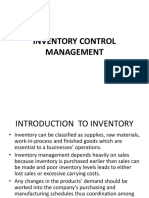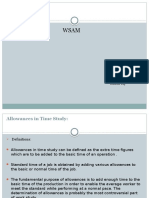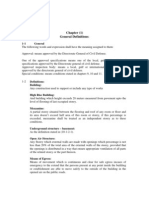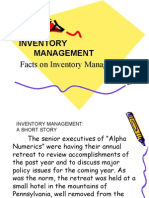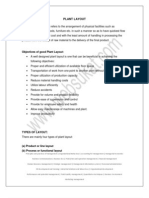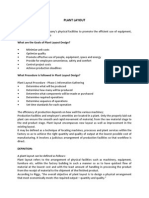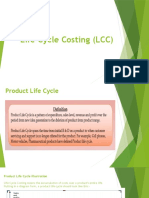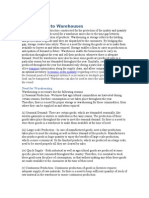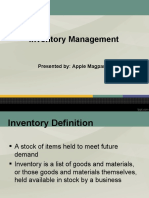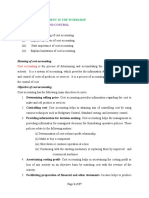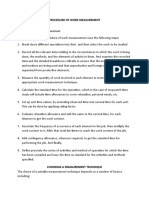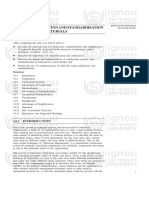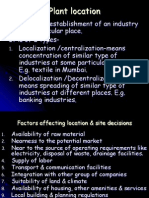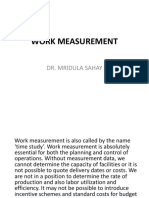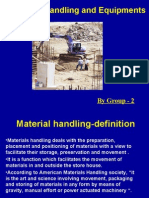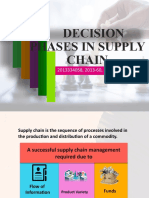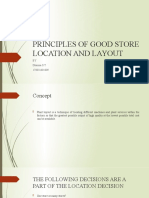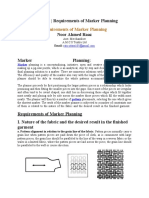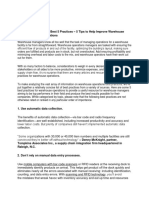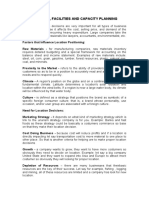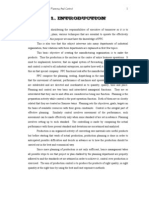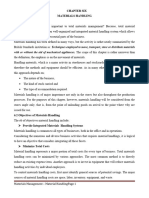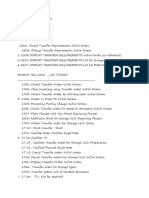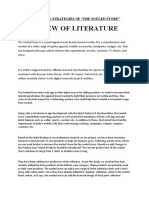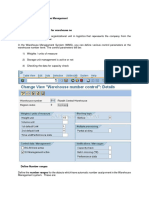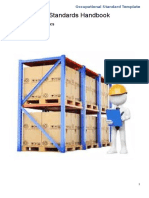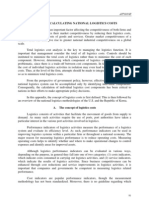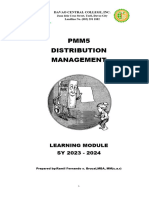20 Principles of Material Handling
20 Principles of Material Handling
Uploaded by
Nerz CionCopyright:
Available Formats
20 Principles of Material Handling
20 Principles of Material Handling
Uploaded by
Nerz CionCopyright
Available Formats
Share this document
Did you find this document useful?
Is this content inappropriate?
Copyright:
Available Formats
20 Principles of Material Handling
20 Principles of Material Handling
Uploaded by
Nerz CionCopyright:
Available Formats
20 Principles of Material Handling These principles are guidelines for the application of sound judgment.
Some principles are in conflict with others, so only the situation being designed will determine what is correct. The principles will be a good checklist for improvement opportunities.
1. Planning Principle All material handling and storage activities need to be planned to obtain maximum overall operating efficiency. Material handling planning considers every move, every storage need and any delay in order to minimize production costs. 2. System Principle The system concept is that all material handling equipment should work together so that everything fits. The system principle integrates as many steps in the process as possible into a single system from the vendor through your plant and out to your customers. It is to integrate as many handling activities as is practical into a coordinated system of operations, covering vendor, receiving, storage, production, inspection, packaging, warehousing, shipping, transportation and customer. An example will be a oil company purchased plastic bottles from an outside manufacturer. The bottles were packaged in a carton of 12 with separators in between. These cartons were placed on a pallet and shipped out to the companys oil bottling plant. In the plant, the bottles were dumped onto a filing line and filled with oil. The empty cartons was conveyed to the packout end of the filing line and repacked with 12 bottles, closed, stacked on a pallet and shipped to the customer. 3. Material Flow Principle It is to provide an operation sequence and equipment layout optimizing material flow. 4. Simplification Principle Using Cost Reduction Formula to simplify handling (Eliminate, combine and reduce unnecessary movement and/or equipment). 5. Gravity Principle There are many ways to make use of gravity to move materials between workstations. Thus, utilize gravity to move material wherever possible. 6. Space Utilization Principle It is to make optimum utilization of the cubic capacity of the warehouse. Racks, mezzanines and overhead conveyors are a few of the material handling equipments that maximize space utilization. 7. Unit Size Principle Strength, durability, versatility, weight, size, cost and ease of use must all be considered when choosing a unit load. It is to increase the quantity, size, or weight of unit loads or flow rate. 8. Mechanization Principle
It is to add power to eliminate manual moving. Mechanization implies the use of mechanical tools to aid in the movement of material. 9. Automation Principle Automatic storage and retrieval systems place material into storage racks automatically and remove it when needed. Many machines are automatic because material handling equipment loads and unloads the machine. Automation is the way of the future, thus even users of the manual system must consider when it can be justified. Provide automation to include production, handling and storage functions. 10. Equipment Selection Principle In selecting handling equipment consider all aspects of the material being handled the movement and the method to be used. 11. Standardization Principle It is to standardize handling methods as well as types and sizes of handling equipment. Cost of material handling systems can be grouped into two categories: the cost of ownership of the system (includes the initial purchase price and the subsequent maintenance costs) and the cost of operation of the system (includes cost of training personnel to use the system safely, energy cost and other direct and indirect costs associated with the use of the system). An example will be choosing a material handling equipment and stay with that brand, type and size because spare parts inventory, maintenance and operation of this equipment will be most cost efficient. 12. Adaptability Principle Use methods and equipment that can best perform a variety of tasks and applications where special purpose equipment is not justified. Examples will be the purchasing of standard size pallets that will handle a range of parts and purchasing of storage equipments that can store a wide variety of products. In this way, change will be less costly. 13. Dead Weight Principle Do not buy equipment that is bigger than necessary. Tare weight refers to the weight of the packaging material. Products are packaged to prevent damage while moving. However, packaging is expensive and it costs as much as the product to ship this tare weight. Thus, the goal is to reduce the tare weight and save money. 14. Utilization Principle Material handling equipment and operators should be used fully. Identifying the work required, the number of times per day and the time required per move will help manage the workload of both labour and equipment. Plan for optimum utilization of handling equipment and manpower. 15. Maintenance Principle Material handling equipment must be maintained. Preventive maintenance (periodic and planned) is cheaper than emergency maintenance. Hence, a preventive maintenance program including schedules must be developed for each piece of material handling equipment. Pallets, storage facilities need to be repair. Missing slats on pallets can cause product damage and
safety problems. Thus, plan for preventive maintenance and scheduled repairs of all handling equipments. 16. Obsolescence Principle As equipment wears out, good maintenance records will help identify worn-out equipments. Replace obsolete handling methods and equipment when more efficient methods or equipment will improve operations. 17. Control Principle Materials are costly and material handling systems can be a part of the inventory control system. With the aid of technology (e.g. conveyor, RFID, barcode), quality inspection, inventory control and item tracking can be incorporated into the material handling systems. It will reduce or eliminate the need to count or track the material physically. A good material handling system allows a tremendous savings in operation time and significant improved costs, accuracy and reliability. Hence, use material handling activities to improve control of production inventory and order handling. 18. Capacity Principle Use handling equipment to help achieve desired production capacity. 19. Performance Principle It is to determine effectiveness of handling performance in terms of expense per unit handled. Material handling labour moves material and a measurement of output could be units of materials moved. Input is labour hours. Therefore, productivity can be improved by increasing the units of material moved or reducing the labour hours. Performance of material handling can also be calculated by ratios: Percent of Material Handling = (material handling hours)/(total labour hours) Performance includes a lot more than labour. Segregating material handling cost from total operation costs would result in a better ratio. 20. Safety Principle Manual handling is probably the most dangerous method of material handling. Material handling equipment can also be a source of safety problems, so safety methods, procedures and training must be part of any material handling plan. It is management responsibility to provide a safe work environment. Safety considerations must be a major factor in selecting material handling equipment. Therefore, it is important to provide suitable methods and equipment for safe handling.
You might also like
- Warehouse Space CalculationsDocument4 pagesWarehouse Space Calculationsunixnet0% (1)
- Principles of Material Handling AssignmentDocument27 pagesPrinciples of Material Handling AssignmentMuriithi MichaelsNo ratings yet
- PowerPoint Presentation On Inventory ControlDocument41 pagesPowerPoint Presentation On Inventory ControlSafwan Shaikh100% (2)
- Basics Techniques of Industrial EngineeringDocument8 pagesBasics Techniques of Industrial Engineeringxubi_xNo ratings yet
- Inventory ManagementDocument25 pagesInventory Managementmba abhi50% (2)
- Chapter 3 - Inventory Control ManagementDocument34 pagesChapter 3 - Inventory Control ManagementShatis kumarNo ratings yet
- Chapter 5: Inventory Management: DPL30033: Fundamentals of Warehouse ManagementDocument14 pagesChapter 5: Inventory Management: DPL30033: Fundamentals of Warehouse ManagementAinIdris 1007100% (1)
- Allowances in Time StudyDocument12 pagesAllowances in Time StudyPreksha PandeyNo ratings yet
- Cold Chain LogisticsDocument65 pagesCold Chain LogisticsMukund Goel0% (1)
- Abu Dhabi Civil Defence Code - Nov '01Document231 pagesAbu Dhabi Civil Defence Code - Nov '01Balaji Jenarthanan100% (2)
- Johnson Elevator Case StudyDocument5 pagesJohnson Elevator Case StudyPJNo ratings yet
- Lecture Eight: Facility LocationDocument12 pagesLecture Eight: Facility LocationRodrigo RampinelliNo ratings yet
- UNIT 1 - Introduction To Material Handling EquipmentsDocument20 pagesUNIT 1 - Introduction To Material Handling EquipmentsAdugna GosaNo ratings yet
- Material HandlingDocument64 pagesMaterial HandlingDaniel Espina100% (1)
- Inventory ManagementDocument77 pagesInventory Managementkevin punzalan100% (16)
- Aggregate PlanningDocument10 pagesAggregate PlanningBipin Bansal AgarwalNo ratings yet
- Material Handling & Storage SystemsDocument22 pagesMaterial Handling & Storage SystemsShikha KathuriaNo ratings yet
- Definition: Plant Layout Refers To The Arrangement of Physical Facilities Such AsDocument5 pagesDefinition: Plant Layout Refers To The Arrangement of Physical Facilities Such AsVinayak MahamuniNo ratings yet
- Plant Layout JenDocument6 pagesPlant Layout JenmgajenNo ratings yet
- Life Cycle Costing (LLC) in Value EngineeringDocument37 pagesLife Cycle Costing (LLC) in Value EngineeringanantarajkhanalNo ratings yet
- Introduction To WarehousesDocument4 pagesIntroduction To WarehousesSumanth Bs100% (4)
- Inventory Management: Presented By: Apple MagpantayDocument31 pagesInventory Management: Presented By: Apple MagpantayRuth Ann DimalaluanNo ratings yet
- Topic 6 Financial Management in The WorkshopDocument27 pagesTopic 6 Financial Management in The Workshopjohn nderitu100% (2)
- Procedure of Work MeasurementDocument2 pagesProcedure of Work MeasurementKhushi GuptaNo ratings yet
- Material HandlingDocument55 pagesMaterial HandlingNishaThakuri100% (2)
- Supply Chain DriversDocument11 pagesSupply Chain DriversamnaNo ratings yet
- Codification and Standardisationof The MaterialsDocument13 pagesCodification and Standardisationof The MaterialsCojanu CozminNo ratings yet
- Plant Location and Layout !!Document32 pagesPlant Location and Layout !!amber19995No ratings yet
- Work MeasurementDocument51 pagesWork MeasurementShadaab AlamNo ratings yet
- Production Mamgnt Ch1Document88 pagesProduction Mamgnt Ch1sjaisonsamNo ratings yet
- Plant LayoutDocument4 pagesPlant LayoutSaul VillarrealNo ratings yet
- Stores Management and Materials HandlingDocument21 pagesStores Management and Materials HandlingMr. Umang PanchalNo ratings yet
- Work MeasurementDocument13 pagesWork MeasurementVincent Alonzo100% (1)
- Work Study Methods in Industrial EngineeringDocument20 pagesWork Study Methods in Industrial EngineeringSanat patilNo ratings yet
- Material HandlingDocument99 pagesMaterial HandlingsalunkensNo ratings yet
- Pricing and Revenue Management in The Supply Chain 17Document20 pagesPricing and Revenue Management in The Supply Chain 17niruthir100% (1)
- Layout TypesDocument6 pagesLayout TypeswearematalabiNo ratings yet
- Material HandlingDocument26 pagesMaterial HandlingRohit AroraNo ratings yet
- Ethical and Sustainable SourcingDocument30 pagesEthical and Sustainable SourcingAshok SharmaNo ratings yet
- Chapter 6 Production Activity ControlDocument7 pagesChapter 6 Production Activity ControlKamble AbhijitNo ratings yet
- Group 3: Plant Layout and Industrial SafetyDocument16 pagesGroup 3: Plant Layout and Industrial Safetylove ofmylifeNo ratings yet
- Warehousing Including Warehousing Decision in Detail and DistributionDocument31 pagesWarehousing Including Warehousing Decision in Detail and DistributionDr. Nimisha Nandan100% (1)
- Basics of Inventory ManagementDocument4 pagesBasics of Inventory Managementsaurav_eduNo ratings yet
- Inventory ManagementDocument24 pagesInventory Managementnishi27777No ratings yet
- Full MCQ SCMDocument87 pagesFull MCQ SCMFidas RoyNo ratings yet
- Materials HandlingDocument34 pagesMaterials HandlingPrachi Singh100% (1)
- Objectives of Production Planning and ControlDocument2 pagesObjectives of Production Planning and ControlDutt Amit100% (2)
- Decision Phases in Supply ChainDocument16 pagesDecision Phases in Supply ChainShowkat HossainNo ratings yet
- Principles of Good Store Location and Layout.Document7 pagesPrinciples of Good Store Location and Layout.st dharmaNo ratings yet
- The 10 Principles of Material HandlingDocument2 pagesThe 10 Principles of Material HandlingHassan Chaudhry0% (1)
- Marker Planning - Requirements of Marker Planning Noor Ahmed RaazDocument4 pagesMarker Planning - Requirements of Marker Planning Noor Ahmed RaazalaminNo ratings yet
- Chapter 6 Storage SystemsDocument53 pagesChapter 6 Storage SystemsTú QuyênNo ratings yet
- Materials ManagementDocument16 pagesMaterials ManagementJoseph George KonnullyNo ratings yet
- Production & Operations Management: Unit - 1Document148 pagesProduction & Operations Management: Unit - 1Sumatthi Devi Chigurupati100% (1)
- Inventory Management SystemDocument16 pagesInventory Management Systempratiktamgadge25No ratings yet
- Warehouse Operations Best 5 PracticesDocument4 pagesWarehouse Operations Best 5 PracticesJochie Teruel100% (1)
- Location, Facilities and Capacity PlanningDocument6 pagesLocation, Facilities and Capacity PlanningharabassNo ratings yet
- A Presentation On Aggregate PlanningDocument17 pagesA Presentation On Aggregate PlanningAhel Patrick VitsuNo ratings yet
- Chapter Seven: Basic Accounting Principles & Budgeting FundamentalsDocument35 pagesChapter Seven: Basic Accounting Principles & Budgeting FundamentalsbelaynehNo ratings yet
- List of Machine and Tools and Equipment Used in Store RoomDocument14 pagesList of Machine and Tools and Equipment Used in Store RoomFahima RashidNo ratings yet
- Production Planning and Control PPC NotesDocument128 pagesProduction Planning and Control PPC NoteskarthikhindustanNo ratings yet
- A Scientific Criteria For Determining A Good Plant LayoutDocument36 pagesA Scientific Criteria For Determining A Good Plant LayoutSenthilKumar SubramanianNo ratings yet
- Material HandlingDocument14 pagesMaterial Handlingdavid.kaweesa352No ratings yet
- 6CHAPTER SIX - Material HandlingDocument6 pages6CHAPTER SIX - Material HandlingmishamomanedoNo ratings yet
- MM CH 6Document7 pagesMM CH 6dawitsam7No ratings yet
- UFO LED High Bay LightDocument18 pagesUFO LED High Bay LightMusembiNo ratings yet
- E TailingDocument26 pagesE TailingPiyush KumarNo ratings yet
- Sap WM 1and2 ExercisesDocument58 pagesSap WM 1and2 ExercisesMadhu Kiran AkulaNo ratings yet
- Designing Omnichannel Fulfillment Operations enDocument10 pagesDesigning Omnichannel Fulfillment Operations entluo001No ratings yet
- Types of LayoutDocument11 pagesTypes of LayoutArden OrpillaNo ratings yet
- CRS 70448 enUSDocument1 pageCRS 70448 enUSCarfin Febriawan Pratama PutraNo ratings yet
- Sap User Exit For DeliveriesDocument2 pagesSap User Exit For Deliveriesamittal111No ratings yet
- Chapter 2Document4 pagesChapter 22046 Karthick RajaNo ratings yet
- CV Examples Uk Warehouse OperativeDocument7 pagesCV Examples Uk Warehouse Operativeplpymkzcf100% (2)
- Online Car Sales Management System by A A Badara PDFDocument71 pagesOnline Car Sales Management System by A A Badara PDFKarthik BhatNo ratings yet
- Cold Supply Chain: Providing Temperature Controlled EnvironmentsDocument3 pagesCold Supply Chain: Providing Temperature Controlled EnvironmentsHarshit Kumar Singh100% (1)
- Chapter 5 - Exemptions From GSTDocument35 pagesChapter 5 - Exemptions From GSTkarnimasoni12No ratings yet
- EWM 2022 Test Script - Table ContentDocument2 pagesEWM 2022 Test Script - Table Contentongkecantho100% (1)
- SRI WM Config Guide-PART1Document11 pagesSRI WM Config Guide-PART1psrikanthNo ratings yet
- Occupational Standards Book Transport and LogisticsDocument65 pagesOccupational Standards Book Transport and LogisticsJoze Herrera Severino100% (3)
- MBA 502 Supply Chain Management Lesson 2Document44 pagesMBA 502 Supply Chain Management Lesson 2smsishaNo ratings yet
- SAP Material Management Frequently Asked QuestionDocument47 pagesSAP Material Management Frequently Asked QuestionSurupa ChakiNo ratings yet
- Final-Scm PPT Big BazaarDocument29 pagesFinal-Scm PPT Big BazaarNirriti Shrawan50% (2)
- IFAMC - 2013 - Export Distribution Channels & PricingDocument6 pagesIFAMC - 2013 - Export Distribution Channels & PricingldandriscollNo ratings yet
- Calculating Logistics CostDocument15 pagesCalculating Logistics CostMaris Violeta100% (2)
- Logistic D53Document8 pagesLogistic D53Rahul SeleriNo ratings yet
- Inbound 4292974060758772366Document105 pagesInbound 4292974060758772366Maria Teresa Bargayo HernandoNo ratings yet
- Zoomlion Gulf FZE Introduction: 1.1 ME Service Support 1.2 Construction CasesDocument13 pagesZoomlion Gulf FZE Introduction: 1.1 ME Service Support 1.2 Construction CasesArk TradingNo ratings yet
- FSR 2011 Freight Suppliers Minimum Security RequirementsDocument19 pagesFSR 2011 Freight Suppliers Minimum Security Requirements1601dejanNo ratings yet
- Logistics Park in India (PT)Document17 pagesLogistics Park in India (PT)rretuNo ratings yet





